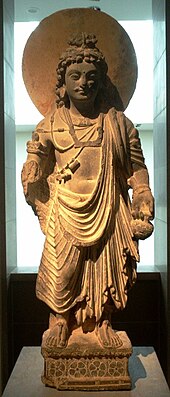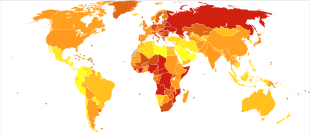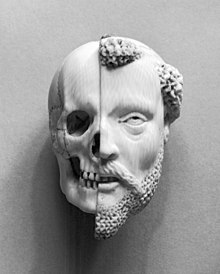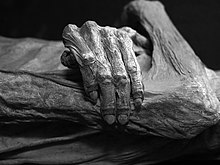The end time (also called end times, end of time, end of days, last days, final days, or eschaton) is a future time-period described variously in the eschatologies of several world religions (both Abrahamic and non-Abrahamic), which teach that world events will reach a final climax.
The Abrahamic faiths maintain a linear cosmology, with end-time scenarios containing themes of transformation and redemption. In Judaism, the term "end of days" makes reference to the Messianic Age and includes an in-gathering of the exiled Jewish diaspora, the coming of the Messiah, the resurrection of the righteous, and the world to come. Some sects of Christianity depict the end time as a period of tribulation that precedes the second coming of Christ, who will face the Antichrist along with his power structure and usher in the Kingdom of God.
In Islam, the Day of Judgement is preceded by the appearance of the al-Masih al-Dajjal, and followed by the descending of Isa (Jesus). Isa will triumph over the false messiah, or the Antichrist, which will lead to a sequence of events that will end with the sun rising from the west and the beginning of the Qiyamah (Judgment day).
Non-Abrahamic faiths tend to have more cyclical world-views, with end-time eschatologies characterized by decay, redemption, and rebirth. In Hinduism, the end time occurs when Kalki, the final incarnation of Vishnu, descends atop a white horse and brings an end to the current Kali Yuga. In Buddhism, the Buddha predicted that his teachings would be forgotten after 5,000 years, followed by turmoil. A bodhisattva named Maitreya will appear and rediscover the teaching of dharma. The ultimate destruction of the world will then come through seven suns.
Since the development of the concept of deep time in the 18th century and the calculation of the estimated age of the Earth, scientific discourse about end times has centered on the ultimate fate of the universe. Theories have included the Big Rip, Big Crunch, Big Bounce, and Big Freeze (heat death).
In Islam, the Day of Judgement is preceded by the appearance of the al-Masih al-Dajjal, and followed by the descending of Isa (Jesus). Isa will triumph over the false messiah, or the Antichrist, which will lead to a sequence of events that will end with the sun rising from the west and the beginning of the Qiyamah (Judgment day).
Non-Abrahamic faiths tend to have more cyclical world-views, with end-time eschatologies characterized by decay, redemption, and rebirth. In Hinduism, the end time occurs when Kalki, the final incarnation of Vishnu, descends atop a white horse and brings an end to the current Kali Yuga. In Buddhism, the Buddha predicted that his teachings would be forgotten after 5,000 years, followed by turmoil. A bodhisattva named Maitreya will appear and rediscover the teaching of dharma. The ultimate destruction of the world will then come through seven suns.
Since the development of the concept of deep time in the 18th century and the calculation of the estimated age of the Earth, scientific discourse about end times has centered on the ultimate fate of the universe. Theories have included the Big Rip, Big Crunch, Big Bounce, and Big Freeze (heat death).
Cyclic cosmology
Indian religions
Buddhism
There are two major points of Buddhist eschatology, the appearance of Maitreya, followed by the Sermon of the Seven Suns.
Maitreya
Buddha
described his teachings disappearing five thousand years from when he
preached them, corresponding approximately to the year 2300. At this
time, knowledge of dharma will be lost as well. The last of his relics will be gathered in Bodh Gaya and cremated.
There will be a new era in which the next Buddha Maitreya will appear,
but it will be preceded by the degeneration of human society. This will
be a period of greed, lust, poverty, ill will, violence, murder,
impiety, physical weakness, sexual depravity and societal collapse, and
even the Buddha himself will be forgotten.
This will be followed by the coming of Maitreya when the teachings of dharma are forgotten. Maitreya was the first Bodhisattva around whom a cult developed, in approximately the 3rd century CE.
The earliest mention of Maitreya is in the Cakavatti, or Sihanada Sutta in Digha Nikaya 26 of the Pali Canon. In it, Gautama Buddha predicted that his teachings of dharma would be forgotten after 5,000 years.
At that period, brethren, there will arise in the world an Exalted One named Maitreya, Fully Awakened, abounding in wisdom and goodness, happy, with knowledge of the worlds, unsurpassed as a guide to mortals willing to be led, a teacher for gods and men, an Exalted One, a Buddha, even as I am now. He, by himself, will thoroughly know and see, as it were face to face, this universe, with Its worlds of the spirits, Its Brahmas and Its Maras, and Its world of recluses and Brahmins, of princes and peoples, even as I now, by myself, thoroughly know and see them
— Digha Nikaya, 26
Maitreya Buddha is then foretold to be born in the city of Ketumatī
in present-day Benares, whose king will be the Cakkavattī Sankha. Sankha
will live in the former palace of King Mahāpanadā, and will become a
renunciate who follows Maitreya.
In Mahayana Buddhism, Maitreya will attain bodhi
in seven days, the minimum period, by virtue of his many lifetimes of
preparation. Once Buddha, he will rule over the Ketumati Pure Land, an
earthly paradise sometimes associated with the Indian city of Varanasi or Benares in Uttar Pradesh. In Mahayana Buddhism, the Buddha presides over a land of purity. For example, Amitabha presides over Sukhavati, more popularly known as the 'Western Paradise'.
Bodhisattva Maitreya from the 2nd-century Gandharan art period
A notable teaching he will rediscover is that of the ten non-virtuous deeds—killing, stealing, sexual misconduct, lying, divisive speech, abusive speech, idle speech, covetousness, harmful intent and wrong views. These will be replaced by the ten virtuous deeds, which are the abandonment of each of these practices. He is described by Conze in his Buddhist Scriptures:
The Lord replied, 'Maitreya, the best of men, will then leave the Tuṣita heavens, and go for his last rebirth. As soon as he is born he will walk seven steps forward, and where he puts down his feet a jewel or a lotus will spring up. He will raise his eyes to the ten directions, and will speak these words: "This is my last birth. There will be no rebirth after this one. Never will I come back here, but, all pure, I shall win Nirvana."
— Buddhist Scriptures
He currently resides in Tushita, but will come to Jambudvipa when needed most as successor to the historic Śākyamuni Buddha.
Maitreya will achieve complete enlightenment during his lifetime, and
following this reawakening, he will bring back the timeless teaching of dharma to this plane and rediscover enlightenment. The Arya Maitreya Mandala, founded by Lama Anagarika Govinda is based on the idea of Maitreya.
Maitreya eschatology forms the central canon of the White Lotus Society, a revolutionary movement during British colonial rule. It later branched into the Chinese underground criminal organization known as the Triad, which exists today as an international underground criminal network.
It is of note that description of Maitreya occurs in no other
sutta in the canon, casting doubt as to authenticity of the scripture.
In addition, sermons of the Buddha normally are in response to a
question, or in a specific context, but this sutta has a beginning and
an ending, and its content is quite different from the others. This has
led some to conclude that the whole sutta is apocryphal, or tampered
with.
Sermon of the Seven Suns
In his "Sermon of the Seven Suns" in the Pali Canon,
the Buddha describes the ultimate fate of the world in an apocalypse
that will be characterized by the consequent appearance of seven suns in
the sky, each causing progressive ruin till the Earth is destroyed:
All things are impermanent, all aspects of existence are unstable and non-eternal. Beings will become so weary and disgusted with the constituent things that they will seek emancipation from them more quickly. There will come a season, O monks when, after hundreds of thousands of years, rains will cease. All seedlings, all vegetation, all plants, grasses and trees will dry up and cease to be...There comes another season after a great lapse of time when a second sun will appear. Now all brooks and ponds will dry up, vanish, cease to be.
— Aňguttara-Nikăya, VII, 6.2 Pali Canon
The canon goes on to describe the progressive destruction of each sun. A third sun will dry the mighty Ganges and other great rivers. A fourth will cause the great lakes to evaporate, and a fifth will dry the oceans. Finally:
Again after a vast period of time a sixth sun will appear, and it will bake the Earth even as a pot is baked by a potter. All the mountains will reek and send up clouds of smoke. After another great interval a seventh sun will appear and the Earth will blaze with fire until it becomes one mass of flame. The mountains will be consumed, a spark will be carried on the wind and go to the worlds of God....Thus, monks, all things will burn, perish and exist no more except those who have seen the path.
— Aňguttara-Nikăya, VII, 6.2 Pali Canon
The sermon completes with the planet engulfed by a vast inferno. The
Pali Canon does not indicate when this will happen relative to Maitreya.
Hinduism
In Hindu eschatology, time is cyclic and consists of kalpas. Each lasts 4.1 – 8.2 billion years, which is a period of one full day and night for Brahma, who will be alive for 311 trillion, 40 billion years. Within a kalpa there are periods of creation, preservation and decline. After this larger cycle, all of creation will contract to a singularity and then again will expand from that single point, as the ages continue in a religious fractal pattern.
Within the current kalpa, there are four epochs that encompass
the cycle. They progress from a beginning of complete purity to a
descent into total corruption. The last of the four ages is Kali Yuga,
our current time, during which will be characterized by impiety,
violence and decay. The four pillars of dharma will be reduced to one,
with truth being all that remains. As written in the Gita:
Yadā yadā hi dharmasya glānirbhavati Bhārata
Abhyutthānam adharmasya tadātmānam sṛjāmyaham
Whenever there is decay of righteousness O! Bharata
And a rise of unrighteousness then I manifest Myself!
At this time of chaos, the final avatar, Kalki,
endowed with eight superhuman faculties will appear on a white horse.
Kalki will amass an army to "establish righteousness upon the earth" and
leave "the minds of the people as pure as crystal."
At the completion of Kali Yuga, the next cycle will begin with a new Satya Yuga,
in which all will once again be righteous with the reestablishment of
dharma. This, in turn, will be followed by epochs of Treta Yuga, Dwapara
Yuga and again another Kali Yuga. This cycle will then repeat till the
larger cycle of existence under Brahma returns to the singularity, and a new universe is born.
Norse religion
Odin fighting his old nemesis Fenrir
Ragnarök after Surtr has engulfed the world with fire
Norse mythology depicts the end of days as Ragnarök, an Old Norse term translatable as "twilight of the gods". It will be heralded by a devastation known as Fimbulvetr which will seize Midgard
in cold and darkness. The sun and moon will disappear from the sky, and
poison will fill the air. Dead will rise from the ground and there will
be widespread despair.
There follows a battle between – on the one hand – the Gods with the Æsir, Vanir and Einherjar, led by Odin, and – on the other hand – forces of Chaos, including the fire giants and jötunn, led by Loki. In the fighting Odin will be swallowed whole by his old nemesis Fenrir. The god Freyr fights Surtr but loses. Víðarr,
son of Odin, will then avenge his father by ripping Fenrir's jaws apart
and stabbing the wolf in the heart with his spear. The serpent Jörmungandr will open its gaping maw and be met in combat by Thor. Thor, also a son of Odin, will defeat the serpent, only to take nine steps afterwards before collapsing to his own death.
After this people will flee their homes as the sun blackens and
the earth sinks into the sea. The stars will vanish, steam will rise,
and flames will touch the heavens. This conflict will result in the
deaths of most of the major Gods and forces of Chaos. Finally, Surtr will fling fire across the nine worlds. The ocean will then completely submerge Midgard.
After the cataclysm the world will resurface new and fertile, and the surviving Gods will meet. Baldr, also a son of Odin will be reborn in the new world, according to Völuspá. The two human survivors, Líf and Lífþrasir, will then repopulate this new earth.
Linear cosmology
Abrahamic religions
Bahá'í Faith
The founder of the Bahá'í Faith, Bahá'u'lláh claimed that he was the return of Christ as well as prophetic expectations of other religions. The inception of the Bahá'í Faith coincides with Millerite prophesy, pointing to the year 1844. They also believe the Battle of Armageddon has passed and that the mass martyrdom anticipated during the End Times had already passed within the historical context of the Bahá'í Faith. Bahá'ís expect their faith to be eventually embraced by the masses of the world, ushering in a golden age.
Christianity
- Date
Some first-century Christians believed Jesus would return during their lifetime. When the converts of Paul in Thessalonica were persecuted by the Roman Empire, they believed the end of days to be imminent.
While some who believe in the literal interpretation of the Bible
insist that the prediction of dates or times is futile, others believe
Jesus foretold signs of the end of days. The precise time, however, will
come like a "thief in the night" (1 Thess. 5:2). They may also refer to Matthew 24:36 in which Jesus is quoted as saying:
But concerning that day and hour no one knows, not even the angels of heaven, nor the Son, but the Father only.
- Great Tribulation
In the New Testament, Jesus refers to this period preceding the end times as the "Great Tribulation" (Matthew 24:21), "Affliction"(Mark 13:19), and "days of vengeance"(Luke 21:22).
The Book of Matthew describes the devastation:
When ye therefore shall see the abomination of desolation, spoken of by Daniel the prophet, stand in the holy place, (whoso readeth, let him understand). Then let them which be in Judaea flee into the mountains. Let him which is on the housetop not come down...Neither let him which is in the field return back to take his clothes, and woe unto them that are with child...For then shall be great tribulation, such as was not since the beginning of the world to this time, no, nor ever shall be. And except those days should be shortened, there should no flesh be saved: but for the elect's sake those days shall be shortened.
The resulting chaos will affect pregnancies, newborns, and a scourge
will spread throughout the flesh, save for the elect. The vivid imagery
of this section is repeated closely in Mark 13:14–20.
The Gospel of Luke describes a complete unraveling of the social fabric, with widespread calamity and war:
Then he said to them, “Nation will rise against nation, and kingdom against kingdom. There will be great earthquakes, and in various places famines and pestilences. And there will be terrors and great signs from heaven. But before all this they will lay their hands on you and persecute you, delivering you up to the synagogues and prisons, and you will be brought before kings and governors for my name's sake. This will be your opportunity to bear witness. Settle it therefore in your minds not to meditate beforehand how to answer, for I will give you a mouth and wisdom, which none of your adversaries will be able to withstand or contradict. You will be delivered up even by parents and brothers and relatives and friends, and some of you they will put to death. You will be hated by all for my name's sake. But not a hair of your head will perish. By your endurance you will gain your lives.
“But when you see Jerusalem surrounded by armies, then know that its desolation has come near. Then let those who are in Judea flee to the mountains, and let those who are inside the city depart, and let not those who are out in the country enter it, for these are days of vengeance, to fulfill all that is written. Alas for women who are pregnant and for those who are nursing infants in those days! For there will be great distress upon the earth and wrath against this people. They will fall by the edge of the sword and be led captive among all nations, and Jerusalem will be trampled underfoot by the Gentiles, until the times of the Gentiles are fulfilled.
“And there will be signs in sun and moon and stars, and on the earth distress of nations in perplexity because of the roaring of the sea and the waves, people fainting with fear and with foreboding of what is coming on the world. For the powers of the heavens will be shaken. And then they will see the Son of Man coming in a cloud with power and great glory. Now when these things begin to take place, straighten up and raise your heads, because your redemption is drawing near.”
And he told them a parable: “Look at the fig tree, and all the trees. As soon as they come out in leaf, you see for yourselves and know that the summer is already near. So also, when you see these things taking place, you know that the kingdom of God is near. Truly, I say to you, this generation will not pass away until all has taken place. Heaven and earth will pass away, but my words will not pass away.
Catholicism
The Profession of Faith addresses Catholic beliefs concerning the Last Days. Catholicism adheres to the amillennial school of thought, promoted by Augustine of Hippo in his work The City of God.
Protestantism
The Antichrist, by Lucas Cranach the Elder (1521) Here the Antichrist is shown wearing the triple crown of the Roman papacy.
Protestants are divided between Millennialists and Amillennialists. Millennialists concentrate on the issue of whether the true believers will see the tribulation or be removed from it by what is referred to as a Pre-Tribulation Rapture. Amillennialists
believe that the end times encompass the time from Christ's ascension
to the Last day, and maintain that the mention of the "thousand years"
in the Book of Revelation is meant to be taken metaphorically (i.e., not literally, or 'spiritually'), a view which continues to cause divisions within evangelical Christianity.
There is a range of eschatological belief in Protestant Christianity. Christian premillennialists
who believe that the End Times are occurring now, are usually specific
about timelines that climax in the end of the world. For some, Israel, the European Union, or the United Nations are seen as major players whose roles were foretold in scripture. Within dispensational premillennialist writing, there is the belief that Christians will be summoned to Heaven by Christ at the Rapture,
occurring before a "Great Tribulation" prophesied in Matthew 24–25;
Mark 13 and Luke 21. The Tribulation is described in the book of
Revelation.
"End times" may also refer to the passing of an age or long period in the relationship between man and God. Adherents to this view cite the Second Epistle to Timothy and draw analogies to the late twentieth and early twenty-first centuries.
Post-Exilic Hebrew books of prophecy such as Daniel and Ezekiel are given new interpretations in this tradition, while in apocalyptic forecasts appear in the Judeo-Christian Sibylline Oracles which include the Book of Revelation ascribed to John, the apocryphal Apocalypse of Peter, and the Second Book Of Esdras.
Most fundamentalist Christians anticipate biblical prophecy to be
literally fulfilled. They see current wars, natural disaster and famine
as the birth pangs which Jesus described in Matthew 24:7–8 and Mark 13:8. They believe that mankind began in the garden of Eden, and point to the Valley of Megiddo as the place where the current world system will terminate, after which the Messiah will rule for 1,000 years.
Contemporary use of the term End Times has evolved from literal belief in Christian millennialism. In this tradition, Biblical apocalypse is believed to be imminent, with various current events as omens of impending Armageddon. These beliefs have been put forward by the Adventist movement (Millerites), Jehovah's Witnesses, and dispensational premillennialists. In 1918 a group of eight well known preachers produced the London Manifesto, warning of an imminent second coming of Christ shortly after the 1917 liberation of Jerusalem by the British.
Icon of the Second Coming. Greek, ca. 1700 A.D.
Religious movements which expect that the second coming of Christ as a cataclysmic event are generally called adventism. These have arisen throughout the Christian era, but were particularly common after the Protestant Reformation. Emanuel Swedenborg considered the second coming to be symbolic, and to have occurred in 1757. Along with others, he developed a religious system around the second coming of Christ, disclosed by new prophecy or special revelation not described in the Bible. The Millerites are diverse religious groups which similarly rely upon a special gift of interpretation for predicting the second coming.
The difference between the 19th-century Millerite and Adventist movements and contemporary prophecy is that William Miller
and his followers, based on Biblical interpretation, predicted the time
of the Second Coming to have occurred in 1844. Contemporary writing of
end time has suggested that the timetable will be triggered by future
wars and moral catastrophe, and that this time of tribulation is close at hand.
Seventh-day Adventists believe Biblical prophecy to foretell an
end time scenario in which the United States works in conjunction with
the Catholic Church to mandate worship on a day other than the true
Sabbath, Saturday, as prescribed in the Ten Commandments (Exodus
20:8–11). This will bring about a situation where one must choose for or
against the Bible as the will of God.
Preterism
Another view of the end times is preterism. It distinguishes the time of the end from the end of time. Preterists believe the term Last Days (or Time of the End) refers to, neither the last days of the Earth, nor the last days of humankind, but the end of the Old Covenant between God and Israel; which, according to preterism, took place when the Temple in Jerusalem which was destroyed in 70 CE.
Preterists believe that prophecies—such as the Second Coming, the desecration of the Jewish Temple, the destruction of Jerusalem, the rise of the Antichrist, the Great Tribulation, the advent of The Day of the Lord, and a Final Judgment—had been fulfilled when the Romans sacked Jerusalem and completely destroyed its Temple.
Proponents of full preterism do not believe in a coming resurrection of the dead. They place this event (as well as the Second Coming) in the year 70. Advocates of partial preterism do believe in a coming resurrection. Full preterists contend that partial preterists are merely futurists, since they believe the Second Coming, the Resurrection, the Rapture, and the Judgment are yet to come.
According with Preterism's interpretation of end times, many "time passages" in the New Testament foretell a Second Coming of Christ, with Last Days to take place within the lifetimes of his disciples: Matt. 10:23, Matt. 16:28, Matt. 24:34, Matt. 26:64, Rom. 13:11–12, 1 Cor. 7:29–31, 1 Cor. 10:11, Phil. 4:5, James 5:8–9, 1 Pet. 4:7, 1 Jn. 2:18.
Dispensationalist prophecies
Dispensationalism is an evangelical futurist Bibilical interpretation that foresees a series of dispensations, or periods, in which God relates to human beings under different Biblical covenants. The belief system is primarily rooted in the writings of John Nelson Darby and is premillennial in content. The reestablishment of Israel
in 1948 provided a major impetus to the dispensationalist belief
system. The wars of Israel after 1948 with its Arab neighbors provided
further support, according to John F. Walvoord. After the Six-Day War in 1967, and the Yom Kippur War in 1973, it seemed plausible to many Fundamentalist Christians
in the 1970s that Middle East turmoil may well be leading up to the
fulfillment of various Bible prophecies and to the Battle of Armageddon.
Members of the dispensationalist movement such as Hal Lindsey, J. Dwight Pentecost, John Walvoord, all of whom have Dallas Theological Seminary backgrounds, and some other writers, claimed further that the European Economic Community, which preceded the European Union, would become a United States of Europe, which would in turn become a Revived Roman Empire ruled by the Antichrist. The Revived Roman Empire also figured into the New Testament
writers' vision of the future. The fact that in the early 1970s, there
were (erroneously thought to be) seven nations in the European Economic
Community was held to be significant; this aligned the Community with a
seven-headed beast mentioned in Revelation. This specific prophecy has
required revision, but the idea of a Revived Roman Empire remains.
The separate destinies of the Church and Israel, a belief which is inherent in dispensationalism,
is a particular concern to some Jews and evangelical Christians.
Evangelicals who reject dispensationalism, such as those who hold to a Post Tribulation Rapture,
(or more accurately a Post Tribulation Resurrection-Rapture), see both
the Church and Israel entering the crucible of the End Time together.
Dispensationalism, in contrast to the Millerite Adventist movement, had its beginning in the 19th century, when John Nelson Darby, founder of the Plymouth Brethren religious denomination, incorporated into his system of Biblical interpretation a system of organizing Biblical time into a number of discrete dispensations, each of which marks a separate covenant with God. Darby's beliefs were widely publicized in Cyrus I. Scofield's Scofield Reference Bible, an annotated Bible that became popular in the United States of America.
Since the majority of the Biblical prophets were writing at a time when the Temple in Jerusalem
was still functioning, they wrote as if it would still be standing
during the prophesied events. According to preterism, this was a
fulfillment of the prophecies. However, according to Futurists,
their destruction in AD 70 put the prophetic timetable on hold. Many
such believers therefore anticipated the return of Jews to Israel and
the reconstruction of the Temple before the Second Coming could occur.
Post-tribulation pre-millennialists
A
view of the Second Coming of Christ as held by post-tribulational
pre-millennialists holds that the Church of Christ will have to undergo
great persecution by being present during the great tribulation.
Specific prophetic movements
William Miller predicted the end of the world in 1843, known as the Great Disappointment
In 1843, William Miller made the first of several predictions that the world would end in only a few months. As his predictions did not come true (referred to as the Great Disappointment), followers of Miller went on to found separate groups, the most successful of which is the Seventh-day Adventist Church.
Members of the Bahá'í Faith believe that Miller's interpretation of signs and dates of the coming of Jesus were, for the most part, correct.
They believe that the fulfillment of biblical prophecies of the coming
of Christ came through a forerunner of their own religion, the Báb. According to the Báb's words, 4 April 1844 was "the first day that the Spirit descended" into his heart. His subsequent declaration to Mullá Husayn-i Bushru'i that he was the "Promised One"—an event now commemorated by Bahá'ís as a major holy day—took place on 23 May 1844. It was in October of that year that the Báb embarked on a pilgrimage to Mecca, where he openly declared his claims to the Sharif of Mecca. The first news coverage of these events in the West was in 1845 by The Times, followed by others in 1850 in the United States. The first Bahá'í to come to America was in 1892.
Several Bahá'í books and pamphlets make mention of the Millerites, the
prophecies used by Miller and the Great Disappointment, most notably William Sears's Thief in the Night.
Restorationism (Christian primitivism)
End times theology is also significant to restorationist Christian religions, which consider themselves distinct from both Catholicism and Protestantism.
Jehovah's Witnesses
Former Watch Tower headquarters in Brooklyn. The society made a number of emphatic claims of impending last days and ensuing chaos between 1879–1924.
The eschatology of Jehovah's Witnesses is central to their religious beliefs. They believe that Jesus Christ
has been ruling in heaven as king since 1914 (a date they believe was
prophesied in Scripture), and that after that time a period of cleansing
occurred, resulting in God's selection of the Bible Students associated with Charles Taze Russell to be his people in 1919. They also believe the destruction of those who reject their message and thus willfully refuse to obey God will shortly take place at Armageddon, ensuring that the beginning of the new earthly society will be composed of willing subjects of that kingdom.
The religion's doctrines surrounding 1914 are the legacy of a series of emphatic claims regarding the years 1799, 1874, 1878, 1914, 1918, and 1925 made in the Watch Tower Society's
publications between 1879 and 1924. Claims about the significance of
those years, including the presence of Jesus Christ, the beginning of
the "last days", the destruction of worldly governments and the earthly
resurrection of Jewish patriarchs, were successively abandoned. In 1922 the society's principal journal, The Watchtower,
described its chronology as "no stronger than its weakest link", but
also claimed the chronological relationships to be "of divine origin and
divinely corroborated...in a class by itself, absolutely and
unqualifiedly correct" and "indisputable facts", while repudiation of Russell's teachings was described as "equivalent to a repudiation of the Lord".
The Watch Tower Society has admitted its early leaders promoted "incomplete, even inaccurate concepts". The Governing Body of Jehovah's Witnesses says that, unlike Old Testament prophets, its interpretations of the Bible are not inspired or infallible. Witness publications
say that Bible prophecies can be fully understood only after their
fulfillment, citing examples of biblical figures who did not understand
the meaning of prophecies they received. Watch Tower publications often
cite Proverbs 4:18, "The path of the righteous ones is like the bright
light that is getting lighter and lighter until the day is firmly
established" (NWT)
to support their view that there would be an increase in knowledge
during "the time of the end", as mentioned in Daniel 12:4. Jehovah's
Witnesses state that this increase in knowledge needs adjustments. Watch
Tower publications also say that unfulfilled expectations are partly
due to eagerness for God's Kingdom and that they do not call their core beliefs into question.
The Church of Jesus Christ of Latter-day Saints
Members of The Church of Jesus Christ of Latter-day Saints
believe that there will be a Second Coming of Jesus to the earth
sometime in the future. The LDS Church and its leaders do not make any
predictions of the actual date of the Second Coming.
According to church doctrine, the true gospel will be taught in all parts of the world prior to the Second Coming.
They also believe that there will be increasing war, earthquakes,
hurricanes, and man-made disasters prior to the Second Coming.
Disasters of all kind will happen before Christ comes.
Upon the return of Jesus Christ, all people will be resurrected, the
righteous in a first resurrection and the unrighteous in a second, later
resurrection. Christ shall reign for a period of 1000 years, after
which the Final Judgement will occur.
Islam
Muslims believe that there are three periods before the Day of Judgment, also known as ashratu's-sa'ah or alamatu qiyami's-sa'ah, with some debate as to whether the periods could overlap.
According to Harun Yahya, the first period is said to have begun
with the death of Muhammad. The second began with the passing of all his
Companions, and ended a thousand years later. Another event of the
second period was the Tartar invasion, occurring 650 years after
Muhammad. The Mongols, led by Hulagu Khan, grandson of Genghis Khan,
attacked Baghdad in 1258 AD and brought the Abbasid caliphate to an
end. They massacred millions of Muslims, and the water of the river
Tigris turned red with blood. A traditional narration also predicted a
fire at Madinah in the Hijaz near Busra
in Syria, which Islamic scholars believe occurred in 654 AH. Following
the second, the third and final period will be heralded by the
appearance of the Mahdi.
Sunni
Sunnis
believe that the dead will then stand in a grand assembly, awaiting a
scroll detailing their righteous deeds, sinful acts and ultimate
judgment. Muhammad will be the first to be resurrected. Punishments will include adhab, or severe pain and embarrassment, and khizy or shame. There will also be a punishment of the grave between death and the resurrection.
The signs of the coming end time are divided into major and minor signs:
Following the second period, the third is said to be marked by the ten major signs known as alamatu's-sa'ah al- kubra (The major signs of the end). They are as follows:
- The false messiah (anti-Christ), Masih ad-Dajjal, shall appear with huge powers as a one eyed man with the right eye blind and deformed like a grape. He will claim to be God and to hold keys to heaven and hell and lead many astray, although believers will not be deceived. In reality, his heaven is the hell, and his hell is the heaven. The Dajjal would be followed by seventy thousand Jews of Isfahan wearing Persian shawls.
- The return of Isa (Jesus), from the fourth sky to kill Dajjal.
- Ya'jooj and Ma'jooj (Gog and Magog), Japhetic tribe of vicious beings which had been imprisoned by Dhul-Qarnayn will break out. They will ravage the earth, drink all the water of Lake Tiberias, and kill all believers in their way (or see). Isa, Imam Al-Mahdi, and the believers with them will go to the top of a mountain and pray for the destruction of Gog and Magog. God will eventually send disease and worms to wipe them out.
- A huge black smoke cloud will cover the earth.
- Dabbat al-ard, or the Beast that will come out of the ground to talk to people.
- The sun will rise from the west.
- Three sinking of the earth, one in the east,
- One in the west,
- And one in Arabia.
- The second trumpet blow will be sounded, the dead will return to life and a fire will start come out of Yemen that shall gather all to Mahshar Al Qiy'amah (The Gathering for Judgment).
Shia
Concepts and terminology in Shia eschatology includes Mi'ad, The Occultation and Al-Yamani, Sufyani In Twelver Shia narrations about the last days, the literature largely revolves around Muhammad al-Mahdi,
a messianic figure considered to be the twelfth appointed successor to
Muhammad. Mahdi will help mankind against the deception by a man called Dajjal who will try to get people in to a new world religion which is called "the great deception".
Ahmadiyya
Ahmadiyya
is considered distinct from mainstream Islam. In its writing, the
present age has been witness to the evil of man and wrath of God, with
war and natural disaster. Ghulam Ahmad is seen as the promised Messiah and the Mahdi,
fulfilling Islamic and Biblical prophecies, as well as scriptures of
other religions such as Hinduism. His teaching will establish spiritual
reform and establish an age of peace. This will continue for a thousand
years, and will unify mankind under one faith.
Ahmadis believe that despite harsh and strong opposition and
discrimination they will eventually be triumphant and their message
vindicated both by Muslims and non-Muslims alike. Ahmadis also
incorporate the eschatological views from other religions into their
doctrine and believe that Mirza Ghulam Ahmed falls into this sequence.
Judaism
Scroll of Book of Isaiah
In rabbinic literature, rabbis elaborated and explained the prophecies that were found in the Hebrew Bible, along with oral law and rabbinic traditions about its significance. The main tenets of Jewish eschatology, in no particular order, include:
- God will redeem Israel from the captivity that began during the Babylonian Exile in a new Exodus.
- God will return the Jewish people to the Land of Israel.
- God will restore the House of David and the Temple in Jerusalem.
- God will raise up a regent from the House of David, the Jewish Messiah, to lead the Jewish people and the world and to usher in an age of justice and peace.
- Nations will recognize that the God of Israel is the only true god.
- God will resurrect the dead.
- God will create a new heaven and earth.
The idea of a messianic age,
an era of global peace and knowledge of the Creator, has a prominent
place in Jewish thought, and is incorporated as part of the end of days.
A well-known passage from the Book of Isaiah
describes this future condition of the world: "They shall beat their
swords into plowshares and their spears into pruning hooks; nation will
not lift sword against nation and they will no longer study warfare"
(2:4) Maimonides (1135–1204) further describes the Messianic Era in the Mishneh Torah:
"And at that time there will be no hunger or war, no jealousy or
rivalry. For the good will be plentiful, and all delicacies available as
dust. The entire occupation of the world will be only to know God...
the people Israel will be of great wisdom; they will perceive the
esoteric truths and comprehend their Creator's wisdom as is the capacity
of man. As it is written (Isaiah 11:9): 'For the earth shall be filled
with the knowledge of God, as the waters cover the sea.'"
The Zohar
maintains that the seven days of the week, based on the seven days of
creation, correspond to the seven millennia of creation. The seventh day
of the week, the Shabbat
day of rest, corresponds to the seventh millennium, the age of
universal rest, or the Messianic Era. The seventh millennium begins with
the year 6000 AM,
and is the latest time the Messiah can come. A number of early and late
Jewish scholars have written in support of this, including the Ramban, Isaac Abrabanel, Abraham Ibn Ezra, Rabbeinu Bachya, the Vilna Gaon, the Lubavitcher Rebbe, the Ramchal, Aryeh Kaplan and Rebbetzin Esther Jungreis.
Rastafari movement
Haile Selassie I is viewed as god incarnate in Rastafarianism
Rastafarians have a unique interpretation of end times, based on the Old Testament and the Book of Revelation. They believe Ethiopian Emperor Haile Selassie I to be God incarnate, the King of kings and Lord of lords mentioned in Revelation 5:5. They saw the crowning of Selassie as the second coming, and the Second Italo-Ethiopian War
as fulfillment of Revelation. There is also the expectation that
Selassie will return for a day of judgment and bring home the lost
children of Israel, which in Rastafarianism refer to those taken from
Africa through the slave trade. There will then be an era of peace and harmony at Mount Zion in Africa.
Zoroastrianism
Zoroastrian eschatology is considered one of the oldest in recorded history. The birth of its founder, Zoroaster, is unknown, with scholarly dates ranging from 6th century BCE to 5,500 years earlier. Pliny the Elder even suggests there were two Zoroasters.
However, with beliefs paralleling and possibly predating the
framework of the major Abrahamic faiths, a fully developed concept of
the end of the world was not established in Zoroastrianism until 500
BCE. The Bahman Yasht describes:
At the end of thy tenth hundredth winter, the sun is more unseen and more spotted; the year, month, and day are shorter; and the earth is more barren; and the crop will not yield the seed. And men become more deceitful and more given to vile practices. They will have no gratitude. Honorable wealth will proceed to those of perverted faith. And a dark cloud makes the whole sky night, and it will rain more noxious creatures than water.
A Manichaean battle between the righteous and wicked will be followed by the Frashokereti. On earth, the Saoshyant will arrive as the final savior of mankind, and bring about the resurrection of the dead. The yazatas Airyaman and Atar
will melt the metal in the hills and mountains, which will flow as lava
across the earth and all mankind, both the living and resurrected, will
be required to wade through it. Ashavan
will pass through the molten river as if it were warm milk, but the
sinful will burn. It will then flow down to hell, where it will
annihilate Angra Mainyu and the last vestiges of wickedness.
The righteous will partake of the parahaoma, which will confer immortality upon them. Humanity will become like the Amesha Spentas,
living without food, hunger, thirst, weapons or injury. Bodies will
become so light as to cast no shadow. All humanity will speak a single
language, and belong to a single nation with no borders. All will share a
single purpose and goal, joining with Ahura Mazda for a perpetual and divine exaltation.
























